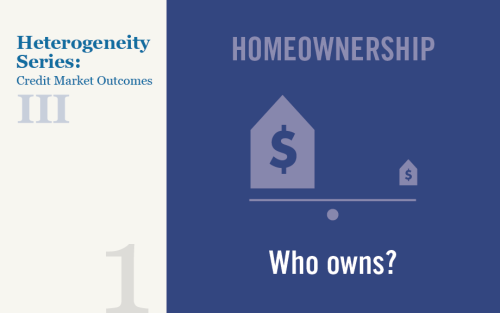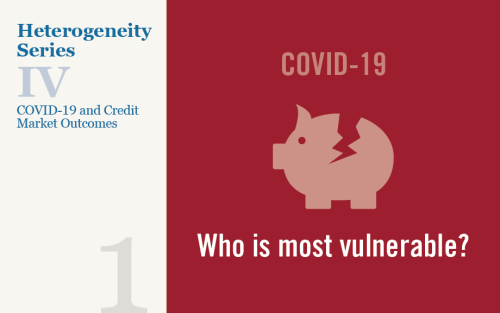Credit Card Balance Declines Are Largest Among Older, Wealthier Borrowers

Total household debt rose by $85 billion in the first quarter of 2021, according to the latest Quarterly Report on Household Debt and Credit from the New York Fed’s Center for Microeconomic Data. Since the start of the pandemic, household debt balances have increased in every quarter but one—the second quarter of 2020, when lockdowns were in full effect. The Quarterly Report and this analysis are based on the New York Fed’s Consumer Credit Panel, which is based on Equifax credit data.
Mortgage Rates Decline and (Prime) Households Take Advantage

Today, the New York Fed’s Center for Microeconomic Data reported that household debt balances increased by $206 billion in the fourth quarter of 2020, marking a $414 billion increase since the end of 2019. But the COVID pandemic and ensuing recession have marked an end to the dynamics in household borrowing that have characterized the expansion since the Great Recession, which included robust growth in auto and student loans, while mortgage and credit card balances grew more slowly. As the pandemic took hold, these dynamics were altered. One shift in 2020 was a larger bump up in mortgage balances. Mortgage balances grew by $182 billion, the biggest uptick since 2006, boosted by historically high volumes of originations. Here, we take a close look at the composition of mortgage originations, which neared $1.2 trillion in the fourth quarter of 2020, the highest single-quarter volume seen since our series begins in 2000. The Quarterly Report on Household Debt and Credit and this analysis are based on the New York Fed’s Consumer Credit Panel, which is itself based on anonymized Equifax credit data.
Inequality in U.S. Homeownership Rates by Race and Ethnicity

Homeownership has historically been an important means for Americans to accumulate wealth—in fact, at more than $15 trillion, housing equity accounts for 16 percent of total U.S. household wealth. Consequently, the U.S. homeownership cycle has triggered large swings in Americans’ net worth over the past twenty-five years. However, the nature of those swings has varied significantly by race and ethnicity, with different demographic groups tracing distinct trajectories through the housing boom, the foreclosure crisis, and the subsequent recovery. Here, we look into the dynamics underlying these divergences and explore some potential explanations.
Just Released: Racial Disparities in Student Loan Outcomes

A $20 billion rise in student loan balances in the third quarter of this year contributed to a $92 billion increase in total household debt, according to the latest Quarterly Report on Household Debt and Credit from the New York Fed’s Center for Microeconomic Data. This post explores racial disparities in student loan outcomes using information about the borrowers’ locations, grouping zip codes based upon which racial group constitutes the majority of an area’s residents.
Just Released: Mind the Gap in Delinquency Rates

Total household debt balances increased by $192 billion in the second quarter of 2019, boosted primarily by a $162 billion gain in mortgage installment balances, according to the latest Quarterly Report on Household Debt and Credit from the New York Fed’s Center for Microeconomic Data (the mortgage installment balances exclude home equity lines of credit, which are reported separately and have been declining in balance for some time). The new mortgage total of $9.4 trillion is slightly higher than the previous high in mortgage balances from the third quarter of 2008 in nominal terms.
Just Released: Shifts in Credit Market Participation over Two Decades
The Sustainability of First‑Time Homeownership

In this post we take up the important question of the sustainability of homeownership for first-time buyers. The evaluation of public policies aimed at promoting the transition of individuals from renting to owning should depend not only on the degree to which such policies increase the number of first-time buyers, but also importantly on whether these new buyers are able to sustain their homeownership. If a buyer is unprepared to manage the financial responsibilities of owning a home and consequently must return to renting, then the household may have made little to no progress in wealth accumulation. Despite the importance of sustainability, to date there have been no efforts at measuring the sustainability of first-time homeownership. We provide an example of a first-time home buyer sustainability scorecard.
Who’s on First? Characteristics of First‑Time Homebuyers

In our previous post, we presented a new measure of first-time homebuyers. In this post, we use this improved measure to describe the characteristics of first-time buyers and how those characteristics change over time. Having an accurate assessment of first-time buyers is important given that the aim of many housing policies is to support the transition from renting to owning. A proper assessment of these housing policies requires an understanding of the impact of these policies on the share of first-time buyers and the characteristics of these buyers. Our third post will directly examine the sustainability of homeownership by first-time buyers.
A Better Measure of First‑Time Homebuyers

Much of the concern about affordable homeownership has focused on first-time buyers. These buyers, who are often making the transition from renting to owning, can find it difficult to save to meet down-payment requirements; this is particularly true in those areas where rent takes up a significant portion of a household’s monthly income. In contrast to first-time buyers, repeat buyers can typically rely on the equity in their current house to help fund the down payment on a trade-up purchase; they also have an easier time qualifying for a new mortgage if they’ve successfully made payments on a prior mortgage, thereby improving their credit score. Despite the policy focus on first-time buyers, reliable data on these buyers do not exist. In this initial post in a three-part series, we introduce a better measure of first-time buyers and examine the dynamics of this group over the past seventeen years. In our next post, we will describe the characteristics of first-time buyers. We will conclude the series by examining the sustainability of homeownership for first-time buyers.












 RSS Feed
RSS Feed Follow Liberty Street Economics
Follow Liberty Street Economics